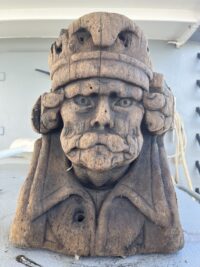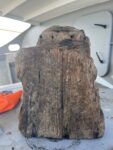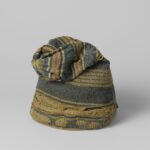 Fishermen casting their nets off the coast of the Wadden Islands, Texel, the Netherlands, hauled in not the delicious shellfish they expected, but a carved wooden head in exceptional condition. The crew of the shrimp cutter Wieringer 22 caught the sculpture on Tuesday, August 2. They named the head Barry and posted him on social media where he garnered an instant following.
Fishermen casting their nets off the coast of the Wadden Islands, Texel, the Netherlands, hauled in not the delicious shellfish they expected, but a carved wooden head in exceptional condition. The crew of the shrimp cutter Wieringer 22 caught the sculpture on Tuesday, August 2. They named the head Barry and posted him on social media where he garnered an instant following.
Acting on advice from archaeologists, the crew placed the head in an eel tub filled with sea water to keep the wood from drying out and deteriorating while the ship was still out shrimping. On Thursday, August 4, the Wieringer 22 came into port where it was greeted by excited archaeologists.
 The head is made of oak, which would under normal circumstances be susceptible to the depredations of shipworm, but the sculpture managed to avoid this fate by embedding itself in the sea floor after the wreck. The sediment prevented marine organisms from making a meal of the figurehead and kept it from rotting away. That coincidence is the only reason it is in such impeccable condition.
The head is made of oak, which would under normal circumstances be susceptible to the depredations of shipworm, but the sculpture managed to avoid this fate by embedding itself in the sea floor after the wreck. The sediment prevented marine organisms from making a meal of the figurehead and kept it from rotting away. That coincidence is the only reason it is in such impeccable condition.
Michiel Bartels, a municipal archaeologist for that region of the Netherlands, told the Leeuwarder Courant that he believed the “very special discovery” came from a warship, possibly during the Eighty Years’ War, which stretched from the mid-1500s to the mid-1600s.
Bartels told the outlet that the man in the carving was wearing a specific kind of headgear called a Phrygian cap. “This hat symbolizes freedom and independence,” he said. “The Phyrigians were enslaved by the Romans. Slaves were shaved bald. When released from slavery, [Phyrigians] wore a cap to hide their baldness and signify their freedom. During the Eighty Years’ War, the symbol came back as a sign of independence.”
Experts believe that Barry – as the crew members called the figure – adorned the stern of the 17th-century ship. “The most important thing is to conserve the sculpture and examine it,” says Ad Geerdink, director of the Westfries Museum. – Many ships from the Dutch East India Company (VOC) rest at the bottom of the Wadden Sea. It is too early to say what kind of unit the sculpture is from. Figures of this type, placed at the stern of ships, were to impress and speak about the origin of the vessel. It was such a frenzy at sea. And this figure fits well with this habit.
The hat could lead researchers in another direction, away from the political symbolism of the 80 Years’ War and towards a profession: whaling. The  Rijksmuseum has a similar woolen cap in its collection. It was one of many discovered in the graves of 185 Dutch whalers and whale oil workers in the Spitsbergen archipelago in Norway. The caps not only kept the sailors and workers warm in the frigid climate, but were markers of identity, each knitted in different colors and patterns. The connection between man and hat was so pronounced not even death could sever it, and many of the Dutchmen were buried wearing their hats.
Rijksmuseum has a similar woolen cap in its collection. It was one of many discovered in the graves of 185 Dutch whalers and whale oil workers in the Spitsbergen archipelago in Norway. The caps not only kept the sailors and workers warm in the frigid climate, but were markers of identity, each knitted in different colors and patterns. The connection between man and hat was so pronounced not even death could sever it, and many of the Dutchmen were buried wearing their hats.
Phrygian cap is sometimes called the liberty cap. It shows up on a number of USA coins, particularly early ones.
Frankly, those ‘enslaved Phrygians’ do not really convince me, to say the least.
If the ship in question went down from the mid-1500s to the mid-1600s it is almost certainly not a Phrygian cap. Also, these Phrygians were not enslaved by the Romans, but in fact turned into Romans. However, only as late as the 1st century BC.
The pileus (πῖλος, pilleus or pilleum in Latin) was a brimless felt cap. In Ancient Rome, a slave was freed in a ceremony in which a praetor touched the slave with a rod called a vindicta and pronounced him to be free. The slave’s head was shaved and a pileus was placed upon it.
To the best of my knowledge, during the French Revolution, the ‘pileus’ was mistaken for the ‘Phrygian cap’, and a lot of folks even started to wear one. In addition to this, it may be worth noticing that before that, the French were playing an active role in the American Revolution.
The ones that got rid of Julius Caesar had chosen a ‘pileus’ as liberty symbol (the *Eid Mar* coins!).
Allegedly, the original version of Phrygian cap was made using the skin of a bull scrotum, but I am unable to confirm this. There are versions of a ‘Tauroctony’ (from ταῦρος «bull» and κτείνω «to kill»), where god Midas cuts the throat of a bull –often wearing already a ‘Phrygian cap’– while a scopion attacks the bull’s scrotum 😮 –Rather wild, innit?
:hattip:
Great answer. I think the god you are referring to is Mithras. The head gear seems to be more complicated than a simple cap so like you I am not convinced that is what it is. Maybe all that time under sea has eroded it strangely. Mustaches are not normally associated with “classical” characters either.
😮 Oh dear! -thanks for noticing– of course I wanted to note “Mithras” instead of “Midas”. I have honestly no idea what went wrong.
Indeed, I am rather buying into the whaling story. The earlier whalers were unable to cook the oil on their wooden ships and had to do it on-shore.
“Whale oil town”, a.k.a. “Smeerenburg” was a whaling settlement on Amsterdam Island in northwest Svalbard in Spitsbergen, founded by the Danish and Dutch in 1619.
The 1607 ‘kayak from the Schiffergesellschaft’ in Lübeck –from the last post– might have been picked up by the Danish or whalers from Lübeck themselves (“Grönlandfahrt”).
The “Noordsche Compagnie” (‘Northern Company’) was a Dutch cartel in the whaling trade, founded by several cities in the Netherlands in 1614 and operating until 1642.
🐋️ 🐳️ 😽️
—–
There is a 1639 painting by Cornelis de Man –”The train oil cookery of the Amsterdam chamber of the Northern Company at Smeerenburg”– stored in the Rijksmuseum Amsterdam. Also, you could picture-search for “C.G. Zorgdrager Groenlandsche visschery” (pre 1720, with pictures and maps). Note that ‘Zorgdragerfjorden’ is a fjord at the northern coast of Nordaustlandet, Svalbard named after Dutch captain Cornelis Gijsbert Zorgdrager
The Dutch in some histories are listed as “discovering” Svalbard as well as some islands now claimed by Russia. In the small world we live in, my friend Ivar Ruud had a cabin and lived on the island where he wrote “Year Long Day”. He is now retired here in Southern California and I think has sold his property holdings there.
As for coming to shore to render whale oil, Basque whalers were doing it in New Found-land and Nova Scotia before Columbus. He might have caught wind of it before he set sail. History is a complicated story.
Someone from my village had been sent by the French on two occasions to the colonies in the West, and finally was killed in the Battle of Camden in 1780, and like many others I do have an uncle in NYC, mine from Lübeck and active in overseas freight, but unfortunately I never made it to America myself.
As far as the Dutch are concerned, it seems as if each town had their own facilities in ‘Smeerburg’, even Veere in Zeeland (southern Netherlands). Like myself, Albrecht Dürer visited Veere, but he reported a stranded whale (today, Veere has no access to the sea anymore). At the entrance to the little harbour, there is a massive whale bone mounted.
:hattip:
———
PS: Adam of Bremen, in the 11th century, certainly knew his Pliny, when he wrote about solstice, the roundness of the globe and how the ‘Danes’ knew about trips to the isles in the West and particularly Vinland, and it is indeed highly likely that Columbus had read them both.
According to the Saga of the Greenlanders (‘Groelendinga saga’), apparently a “Sudrmdr” –a “Southener”, i.e. German or Saxon– named “Tyrkir” had been aboard Leif’s ship. He allegedly also had been the one, who got lost and then returned excited with those grapes or ‘vínber’. OK, neither ‘Germany’ nor the ‘Netherlands’ were established entities.
Back then, it may have been “Saxony” –in as well, what today is Germany as in the Netherlands– Tyrkir may have been “Saxon” –’Thjodrikr’/ ‘Dietrich’ or ‘Dirk’– in the saga refered to as “fostri”, i.e. Leif’s foster-father. He might have been an enslaved monk. – If so, even Leif himself may have known about Pliny’s ‘Naturalis Historia’ 😉
——-
PS: “Tyrkir” claims that vine would be growing, where he originally came from, so he might have been “collected” from the Rhine, but there certainly would be a few other possibilities.
——-
Adam of Bremen annotates in the 11th century:
..The third enclosure is Halagland closer to Nortmannia, in size not different from the others. Around solstice, this [place] sees in Summer for fourteen days the sun constantly over the land, and in Winter, similarly for the same amount of days, it completely lacks any sun. It is this a shocking and strange thing to the Natives, who do not know that the uneven length of days is caused by the access and recess of the sun. Moreover, the round shape of the globe necessitates that the course of the accessing sun brings day, and otherwise the recessing sun leaves night. As it accesses to summer solstice, it prolongates the days and shortens the nights to those that are in the North; and while it descends to winter solstice, it brings the corresponding to those in the South. Unaware of that, the pagans call that land holy and happy, because it presents those miracles to the mortals. This has now been confirmed by the king of the Danes and many others happening there as it does in Sweden and in Norway and the rest of the islands over there.
“Additionally, he lets us know about a newly found island among the many in that ocean, which is referred to as ‘Winland’, because grapevines grow there on their own, bearing the best vines (‘..insulam recitavit a multis in eo repertam oceano, quae dicitur Winland, eo quid ibi vites sponte nascantur, vinum optimum ferentes..’). That over there the abundant crops are not sown, we get to know not only from fanciful opinion but from the true account of the Danes. Beyond that island, he says, habitable land is not found in that ocean, instead all territories beyond are full of intolerable ice and immense fog. On this, Martianus comments as follows: One day of sailing beyond Thule, he says, the sea is frozen. Harald, the most enterprising leader of the Normans, recently tried that. He who searched with his ships the northern latitude at last backed down safely from the nebulous harsh extreme end of the world, hardly avoiding tha vast abyss of Hell by reversing his track.”
———